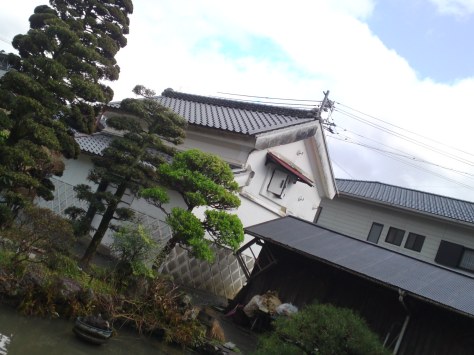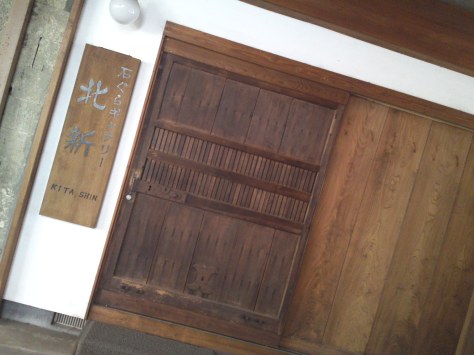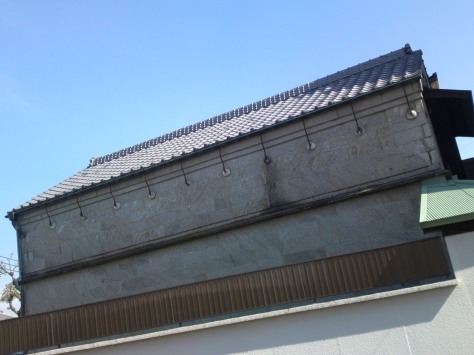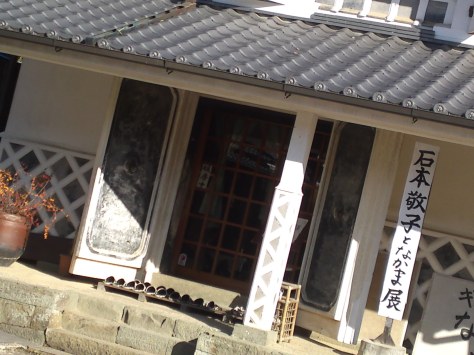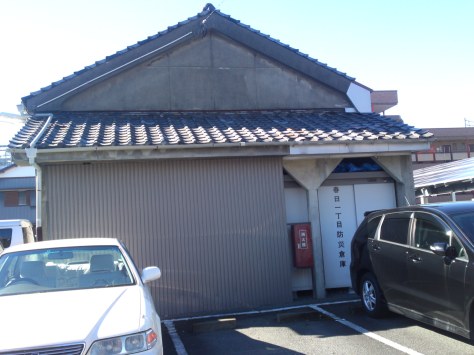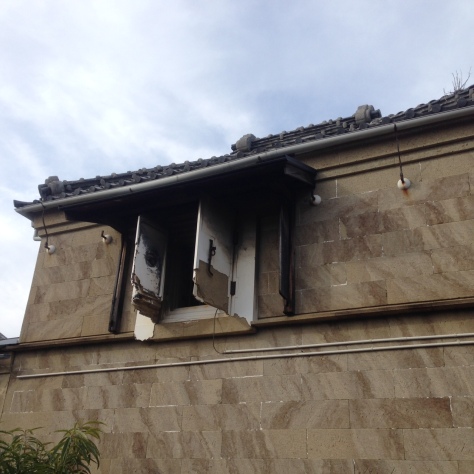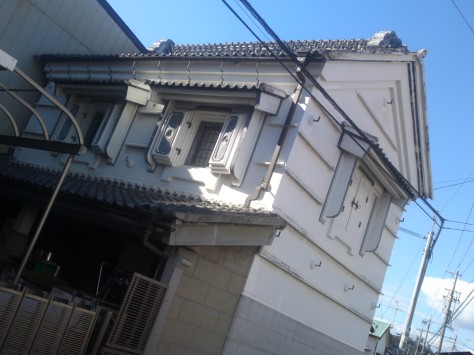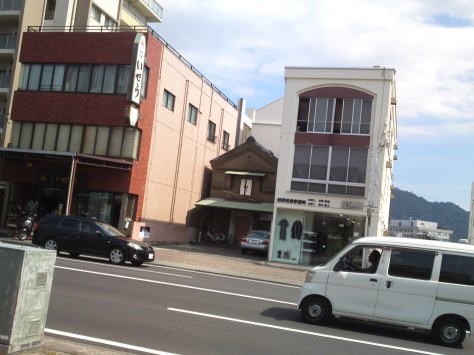Kura: Traditional Japanese Warehouse in Shizuoka Prefecture 20: Former Suzuki Honkei Sake Brewery Kura in Shimizu Ku, Shizuoka City!
“Kura” (in Japanese 蔵 or 倉) means “warehouse” or “Storehouse”.
In traditional Japan, especially during the Edo Era, as most of buildings and urba/village structures were made of wood, fires were the bane of society by and large.
However well-protected a fire would consume a house or buildings and all its properties within minutes.
Hence a special building or warehouse was needed to protect goods and properties against such a catastrophe.
But erecting a storehouse solely made of concrete, stones and some metal cost a vast amount of silver and gold and only rich merchants and nobility could afford them. Even castles could not be built entirely of stone then.
The other I noticed the pinion of a kura peeking over the greenery as I was cycling along a back road in Shimo, Aoi Ku, Shizuoka City!
I didn’t really know what to do of it as the access seemed completely blocked.
Anyway I decided to walk around and find out!
I did meet a neighbor farmer who kindly told me this was not his, bit a neighbor’s kura and that I would have to walk around to find an access, if there was one.
I only met another farmer who also kindly explained it was another farmer’s property!
He mentioned that it was practically abandoned but that it served as a rice storage kura in old times!
Since then it had probably been transformed into a farm tool shack judging from the somewhat decrepit lower half!
But the front is still worth looking at!
Still a great window!
—————————————————————————–
Kura: Traditional Japanese Warehouse in Shizuoka Prefecture 20: Former Suzuki Honkei Sake Brewery Kura in Shimizu Ku, Shizuoka City!
“Kura” (in Japanese 蔵 or 倉) means “warehouse” or “Storehouse”.
In traditional Japan, especially during the Edo Era, as most of buildings and urba/village structures were made of wood, fires were the bane of society by and large.
However well-protected a fire would consume a house or buildings and all its properties within minutes.
Hence a special building or warehouse was needed to protect goods and properties against such a catastrophe.
But erecting a storehouse solely made of concrete, stones and some metal cost a vast amount of silver and gold and only rich merchants and nobility could afford them. Even castles could not be built entirely of stone then.
Befoer it was merged with Shimizu Brewery into the present Sanwa Brewery in Shimizu Ku, Shizuoka City, Suzuki Honkei was active producing Japanese sake in Jirochou, Shimizu City before another kind of merger put the three of them into Shizuoka City!
The Suzuki Family still lives there as was confirmed by the locals when I asked them during the Shimizu Harbor Festival!
The kura standing beside the main house is still in beautiful repair!
Whatever angle you look at it from, it is really impressive!
I wish they would still brew sake as I would visit it every day!
———————————————————————————
Kura: Traditional Japanese Warehouse in Shizuoka prefecture 19: Former Inoue Sake Brewery Kura in Shizuoka City!
“Kura” (in Japanese 蔵 or 倉) means “warehouse” or “Storehouse”.
In traditional Japan, especially during the Edo Era, as most of buildings and urba/village structures were made of wood, fires were the bane of society by and large.
However well-protected a fire would consume a house or buildings and all its properties within minutes.
Hence a special building or warehouse was needed to protect goods and properties against such a catastrophe.
But erecting a storehouse solely made of concrete, stones and some metal cost a vast amount of silver and gold and only rich merchants and nobility could afford them. Even castles could not be built entirely of stone then.
In kutsunoya Cho, Aoi Ku, Shizuoka City, near the Atago Shinto Shrine Inoue sake Brewery used to stand there.
Unfortunately when hos father died some 13 years ago, his son working for Shizuoka Bank preferred money over culture and sold most of the land to a sushi restaurant destroying centuries-old tress and walls in the process.
Now only a house where his mother still lives and an abandoned kura bear witness of the past.
The kura was not pulled down because that part of the land could not be sold and it would cost too much money as the walls are still very solid.
On the hand the inside has been emptied of all past relics and stands empty and forlorn.
The wooden frame and lintels of the superb windows are going to dust.
The roofing is still in good repair, though!
Even an earthquake has little chance to bring it down!
Tell me, Mr. Inoue, how long will we enjoy its sight?
———————————–
Kura: Japanese Traditional Warehouses in Shizuoka Prefecture 18: Old Farm Kura In Shizuoka City!
“Kura” (in Japanese 蔵 or 倉) means “warehouse” or “Storehouse”.
In traditional Japan, especially during the Edo Era, as most of buildings and urba/village structures were made of wood, fires were the bane of society by and large.
However well-protected a fire would consume a house or buildings and all its properties within minutes.
Hence a special building or warehouse was needed to protect goods and properties against such a catastrophe.
But erecting a storehouse solely made of concrete, stones and some metal cost a vast amount of silver and gold and only rich merchants and nobility could afford them. Even castles could not be built entirely of stone then.
Yesterday, because of the typhoon I decided to walk all the way to a destination I usually reach by biycle and had the opportunity to discover an old, if a bit samall, kura in Chiyo 4 Chome, Aoi Ku, Shizuoka City!
It must have been used for ages considering the shed abutting it!
The end window was in good repair, though.
The “namako” design at the bottom of the wall was flaking away on the other hand!
The roof tiling and the upper wall metal work was also in good enough condition.
The window from another angle.
Pity the derelict shed was blocking the total view!
The roof pinion was also in good repair, so the kura must be used as a shed/shck for farm tools!
The farmhouse looks as old as the kura but might be replaced in the near future!
————————————-
Japanese Traditional Warehouses in Shizuoka Prefecture 18: Jinseido in Shizuoka City!
“Kura” (in Japanese 蔵 or 倉) means “warehouse” or “Storehouse”.
In traditional Japan, especially during the Edo Era, as most of buildings and urba/village structures were made of wood, fires were the bane of society by and large.
However well-protected a fire would consume a house or buildings and all its properties within minutes.
Hence a special building or warehouse was needed to protect goods and properties against such a catastrophe.
But erecting a storehouse solely made of concrete, stones and some metal cost a vast amount of silver and gold and only rich merchants and nobility could afford them. Even castles could not be built entirely of stone then.
I was puff puffing on my bicycle at the end of a 5-hour ride Miho Peninsula in Shimizu Ku, Shziuoka City and that probably helped noticing this beautifully preserved kura on my right as I was cycling back through Oya, Suruga ku, shizuoka City!
A “vertical picture” first!
a “horizontal picture” next!
It is owned by a herb medicine/kanpouyaku/漢方薬 Shop called Jinsido/仁生堂!
I’m pretty certain it an ancient company and it certainly needed such a kura to preserve medicines and documents!
They must still be using it!
Look at that beautiful door!
The front window and blinds!
And walls and roof!
Absolutely superb!
As for the shop itself, it is not a kura, but it has obviousl been restored in harmony with the kura!
Unfortunately I didn’t have the courage to visit, but it must be worth it!
————————
Kura: Japanese Traditional Warehouses in Shizuoka Prefecture 17: Wagura izakaya in Shimada City!
“Kura” (in Japanese 蔵 or 倉) means “warehouse” or “Storehouse”.
In traditional Japan, especially during the Edo Era, as most of buildings and urba/village structures were made of wood, fires were the bane of society by and large.
However well-protected a fire would consume a house or buildings and all its properties within minutes.
Hence a special building or warehouse was needed to protect goods and properties against such a catastrophe.
But erecting a storehouse solely made of concrete, stones and some metal cost a vast amount of silver and gold and only rich merchants and nobility could afford them. Even castles could not be built entirely of stone then.
The other day I had arrived early for an appointment in front of Shimada JR station north exit and dedcided to a walk around the neighborhood, hoping against the odds to find something new and interesting in spite of visiting the place at least once a week!
Out of the blue, figuratively as it was almost dusk and evrything was turning shades of grey and blue, I found one large building housing local izakaya. My eyes were attracted by the traditional lattice design/namako at the lower part of the walls. The building itself was not a kura but my curiosity kept me looking beyond to the next house… and there for all to see stood a splendid kura! Why the heck hadn’t I noticed before!
I probably had never bothered to look up to discover this beautiful window!
One other reason was because the whole edifice had been transformed into a traditional izakaya restaurant and the door hadN’t attracted my attention util then
Mind you it is in a back street you do need a purpose to visit otherwise!
Roofing perfectly maintained!
obviously the neighboring building must have belonged to a rich family who protected their belongings indie that kura!
Its lower wall is also designed with a namako-style lattice pattern!
Great atmosphere!
——————————-
Kura: Japanese Traditional Warehouses in Shizuoka Prefecture 16: Kanaya, Shimada City!
“Kura” (in Japanese 蔵 or 倉) means “warehouse” or “Storehouse”.
In traditional Japan, especially during the Edo Era, as most of buildings and urba/village structures were made of wood, fires were the bane of society by and large.
However well-protected a fire would consume a house or buildings and all its properties within minutes.
Hence a special building or warehouse was needed to protect goods and properties against such a catastrophe.
But erecting a storehouse solely made of concrete, stones and some metal cost a vast amount of silver and gold and only rich merchants and nobility could afford them. Even castles could not be built entirely of stone then.
I found this comparatively middle-sized kura in Kanaya, Shimada City during my recent Tea Festival coverage!
It looked old enough although in good repair. Only the windows showed its age as the concept of the walls in base stones and and hard concrete block made it very resistant!
An old Japanese talkative lady very proud of the more than the 90 years she lived in the city informed us that this kura was owned by the Matsumura Family apparently the richest in Kanaya.
Since she told us she used to play nearby as a kid we can imagine the age of the edifice!
A very sturdy and well-maintained kura still used as a shed!
———————–
Kura: Japanese Traditional Warehouses in Shizuoka Prefecture 15: Ieyama, Shimada City!
“Kura” (in Japanese 蔵 or 倉) means “warehouse” or “Storehouse”.
In traditional Japan, especially during the Edo Era, as most of buildings and urba/village structures were made of wood, fires were the bane of society by and large.
However well-protected a fire would consume a house or buildings and all its properties within minutes.
Hence a special building or warehouse was needed to protect goods and properties against such a catastrophe.
But erecting a storehouse solely made of concrete, stones and some metal cost a vast amount of silver and gold and only rich merchants and nobility could afford them. Even castles could not be built entirely of stone then.
i discovered this small but well-preserved kura in Ieyama, a famous small hot spring resort along the Oigawa Railway Line in Shmada City.
It belongs to the Suzuki Family who had a sake brewery called Suzuki Brewery there until 1940 until they had to close it due to WWII. They never resumed the brewing of sake but they kept the kura all the time.
It still has a “namako” design on its lower hall.
It is basically empty now, but the owners keep it into good repair!
The wall facing the road had to be protected with corrugated iron though.
But the windows are nicely up-kept!
I wonder if you could open a cafe inside!
—————————-
Kura: Japanese Traditional Warehouses in Shizuoka Prefecture 13: Kura & Old Japanese Houses in Fukuroi City!
“Kura” (in Japanese 蔵 or 倉) means “warehouse” or “Storehouse”.
In traditional Japan, especially during the Edo Era, as most of buildings and urba/village structures were made of wood, fires were the bane of society by and large.
However well-protected a fire would consume a house or buildings and all its properties within minutes.
Hence a special building or warehouse was needed to protect goods and properties against such a catastrophe.
But erecting a storehouse solely made of concrete, stones and some metal cost a vast amount of silver and gold and only rich merchants and nobility could afford them. Even castles could not be built entirely of stone then.
the other day as I was walking along a main street at a walking distance from Fukuroi JR Station I found myself facing at a scene of another era right across from the sidewalk!
I can’t imagine how long it will survive so I decided to the whole for posterity!
It is actually very much of a sprawling property whose land will eventually interest developers along this newly paved road and pavemnent!
At times bygone it must have been the property of a rich trading family as a wide river flows not far from there!
The kura is certainly big and so full of tradition with a dry stone foundation and a “namako design” style lower wall!
This must be very old and only a rich family could afforded that! It must date back to well before the WWII and probably far more!
The walls, roof and tiles are still in good repair but the rain water piping is about to crumble down!
Looking at the state of the entrance and front wall it must have been locked up for quite a while!
Mysteries, mysteries….
————————————
Kura: Japanese Traditional Warehouses in Shizuoka Prefecture 12: Kita Shin Ishikura Gallery, Shimizu Ku, Shizuoka City
“Kura” (in Japanese 蔵 or 倉) means “warehouse” or “Storehouse”.
In traditional Japan, especially during the Edo Era, as most of buildings and urba/village structures were made of wood, fires were the bane of society by and large.
However well-protected a fire would consume a house or buildings and all its properties within minutes.
Hence a special building or warehouse was needed to protect goods and properties against such a catastrophe.
But erecting a storehouse solely made of concrete, stones and some metal cost a vast amount of silver and gold and only rich merchants and nobility could afford them. Even castles could not be built entirely of stone then.
the other day as I was looking around Jirosho area in Shimizuoka, Shizuoka City for more old kuras, I almost missed this one peeking above a wooden gate!
i decided to put on my impertinent coat on and investigate at the risk of breaking somebody’s privacy!
It certainly looked very intriguing as it definitely seemed to be used in spite of his ancient look!
I checked the old door, but it was locked up!
I checked behind and found the dustbins sitting beside another door. Intriguing….
i was about to give up when I noticed another grand door with a sign saying Kita Shin Ishikura Gallery!
Well. well…
I was still about to leave when a grand lady just came out of the smae door.
I politely inquired what the kura was all about!
She kindly explained that at one time she was about to have the edifice pulled but friends convinced her to preserve it and even transform it into a kind a gallery space for rent!
The place inside is exquisite indeed with some very remarkable decoration made up with existing wood material inside!
Edo time rafters!
Unluckily the inside was a bit too dark for good photographing.
The lady also mentioned that private parties and concerts were also held there.
A place I will definitely have to visit again at length!
————————————
Kura: Japanese Traditional Warehouses in Shizuoka Prefecture 11: Jirosho area, Shimizu Ku, Shizuoka City
“Kura” (in Japanese 蔵 or 倉) means “warehouse” or “Storehouse”.
In traditional Japan, especially during the Edo Era, as most of buildings and urba/village structures were made of wood, fires were the bane of society by and large.
However well-protected a fire would consume a house or buildings and all its properties within minutes.
Hence a special building or warehouse was needed to protect goods and properties against such a catastrophe.
But erecting a storehouse solely made of concrete, stones and some metal cost a vast amount of silver and gold and only rich merchants and nobility could afford them. Even castles could not be built entirely of stone then.
An imposing kura!
This time I decided to visit Jirosho area in Shimizu Ku, Shizuoka City, as it used to be a harbor at the mouth of Tomoe River. The sea access has since been built on and now the whole area is away from the sea along an extended Tomoe River mouth.
This particular kura is in very good repair in spite of its old rain water pipes!
Imposing windows!
Only the wooden lintels give an idea of its old age!
This particular one was completely isolated between other buildings and completely inaccessible!
Some of these kuras look almost brand new like the one above!
Since its facade has obviously just been repainted it is regularly used!
Even the roof is in great repair!
The roof peak has just been replaced!
An enormous and really ancient one wholly covered with ivy!
Although very old, it is still in good repair. The green pipes are so beautiful! Real antiques!
Unfortunately it was completely locked out!
I couldn’t find any indications of ownership…
Another one in good repair with a newly tiled roof!
Note the iron holds securing the roof onto the wall!
It is obviously used as part of a big property!
Must be used as a real warehouse, but for what?
I reported on this one before.
There is actually a kura fan club in Shimizu Ku who made up a map of all kuras with photos but the owners of that particular kura obtained its retrieval for privacy reasons!
The owners apparently do not want people to know about something…
Another kura disappearing between new buildings!
A real pity!
I discovered this inhabited one by chance along a narrow side street!
Someone is using an air conditioner inside!
But I couldn’t get access to the rest of it!
I discovered two more very interesting kuras but that is for two separate articles!
———————–
Kura: Japanese Traditional Warehouses in Shizuoka Prefecture 10
Partly stone-built kura in Yoshiwara, Fuji City!
“Kura” (in Japanese 蔵 or 倉) means “warehouse” or “Storehouse”.
In traditional Japan, especially during the Edo Era, as most of buildings and urba/village structures were made of wood, fires were the bane of society by and large.
However well-protected a fire would consume a house or buildings and all its properties within minutes.
Hence a special building or warehouse was needed to protect goods and properties against such a catastrophe.
But erecting a storehouse solely made of concrete, stones and some metal cost a vast amount of silver and gold and only rich merchants and nobility could afford them. Even castles could not be built entirely of stone then.
This very old kura I discovered along the street leading to Bishamonten Myouhouji Shrine/Temple in Yoshiwara, Fuji City, has the particularity to have walls covered with chiseled stone slabs, an unusual occurence in our Prefecture!
Although the iron window and door curtains are very old it is still used as demonstrated by the recent water drain pipes!
Another unusual feature: a very small window not leading to the actual inside of the kura but into its foundation!
Looking at it from the side it is practically double-walled.
Very solid, indeed!
I discovered this small-sized cocncrete block kura south of Yaizu City JR Station!
It certainly looks old but the concrete blocks would denote its date just after WWII!
It is still used as a warehouse. After all Yaizu City is a trading and fishing port city!
—————————
Kuras in Utsunoya and Okabe
Kura in Kashibaya Inn, Okabe, Fujieda City!
“Kura” (in Japanese 蔵 or 倉) means “warehouse” or “Storehouse”.
In traditional Japan, especially during the Edo Era, as most of buildings and urba/village structures were made of wood, fires were the bane of society by and large.
However well-protected a fire would consume a house or buildings and all its properties within minutes.
Hence a special building or warehouse was needed to protect goods and properties against such a catastrophe.
But erecting a storehouse solely made of concrete, stones and some metal cost a vast amount of silver and gold and only rich merchants and nobility could afford them. Even castles could not be built entirely of stone then.
During my trip last week in Okabe, Fujieda City and Utsunoya, Shizuoka City, I noticed this small kura along the way to Utusunoya at a bend of the road with no more houses and under the shade of the mountain.
It had been converted into a no-limit shelter for the Utsunoya water pomp!
The original location is not fortuitous as it stands in the shade all day long!
It is still relatively new but the concept is traditional!
No way you can get in!
When I visited the Great Inn Kashibaya in Okabe, Fujieda City, I noticed two big kuras in perfect state behind the Inn!
Actually the two big kuras belonged to a man called Ryoukichi who owned the Inn and also operated a pawn shop in the two kuras!
They were built in 1836.
Although the Inn burnt down twice, the kuras survived all that time!
Both of them now house a museum and gallery!
“Namako” design walls!
It is also used for private art exhibitions!
—————————
Kura: Japanese Traditional Warehouses in Shizuoka Prefecture 8: Okabe, Fujieda City with Atsuko Kurata!
hatsukame Brewery warehouse!
“Kura” (in Japanese 蔵 or 倉) means “warehouse” or “Storehouse”.
In traditional Japan, especially during the Edo Era, as most of buildings and urba/village structures were made of wood, fires were the bane of society by and large.
However well-protected a fire would consume a house or buildings and all its properties within minutes.
Hence a special building or warehouse was needed to protect goods and properties against such a catastrophe.
But erecting a storehouse solely made of concrete, stones and some metal cost a vast amount of silver and gold and only rich merchants and nobility could afford them. Even castles could not be built entirely of stone then.
This time my good friend, ms. Atsuko Kurata is taking us to Okabe, which was merged some time ago to Fujieda City!
if you do not have a car 8by bicycle is possible, though) you can take a bus from Shizuoka JR Station North Exit!
Take the no 84 or 85 bus from bus stop platform .
It is Chubu Kokudo Line/中部国道線 heading for Fujieda station. Buses leave every 20 minutes.
You will reach your destination in roughly 35 minutes ride.
Get off at Okabesyuku-Kashibaya-Mae/岡部宿柏屋前 bus stop.
The fare is 570 yen for one way. Children under 12 pay half price for 250 yen
You will find Hatsukame jouzou/is right across from the bus stop!
Hatsukame Brewery is a beautiful complex with an ancient house and a kura who will find on its right!
Can you spot the kura?
Getting close!
Behind beautiful pine trees!
When they build the new road the city pulled out all the pine trees on the east side!
Fortunately you can still see the pine trees on one side giving a good idea of the atmosphere around this brewery, the oldest in Shizuoka Prefecture (end of 17th century!)
Another view of the second side of the kura!
A closer view of the beautiful window!
There are actually two more warehouses along the same street!
This one is quite similar to Hatsukame Brewery kura!
For a closer view… It is completely surrounded by other buildings!
The second kura! Very imposing!
Very well preserved!
It is quite tall and certainly requires much maintenance!
———————————————-
Kura: Japanese Traditional Warehouses in Shizuoka Prefecture 7
“Kura” (in japanese 蔵 or 倉) means “warehouse” or “Storehouse”.
In traditonal Japan, especially during the Edo Era, as most of buildings and urba/village structures were made of wood, fires were the bane of society by and large.
However well-protected a fire would consume a house or buildings and all its properties within minutes.
Hence a special building or warehouse was needed to protect goods and properties against such a catastrophe.
But erecting a storehouse solely made of concrete, stones and some metal cost a vast amount of silver and gold and only rich merchants and nobility could afford them. Even castles could not be built entirely of stone then.
I was reporting on a local festival in Yui, Shimizu Ku, Shizuoka City, when I discovered two more kuras!
Actually there are many of them in Yui, especially along and the Old Tokaido Road where they were the first refuge against typhoons and tsunamis.
But most of them have now been transformed into hangars, shops and abodes with their second floors shaved off and using only the solid first floor as a base.
Therefore there only a very few with their roof intact!
I noticed this one by pure chance as it was completely surrounded by buildings of all kinds!
It was obviously used either as an abode or as a storeroom, and I managed to a peek at this window as the inhabitants seemed to be away during the New Year Holidays!
I found this old one along the same street. As it was surrounded by a car park I had an easier access to it!
The entrance was being repaired but the whole building, although small, seemed very till very solid!
The window and the roof were in good repair!
These iron supports are found in most kuras. They are there to keep the roof securely onto the walls in case of stong winds. Typhoons can easily send the tiles flying!
For all the lack of color and decoration it was very well-preserved!
Now, that window lock really looks ancient!
Now some of these kuras can very small indeed!
I found this one near my home!
Small but very old as shown by all the rust on the window!
At first I didn’t think that this long building was a kura!
I nonetheless decided to investigate!
For all the imposing solidity the large steel windows were old!
No openings at the back!
They had reformed the entrance, though!
It is effectively used as a kura by the local fire station!
————————————————–
Kura: Japanese Traditional Warehouses in Shizuoka Prefecture 6: Shimizu Ku, Shizuoka City with Atsuko Kurata!
We will have to check this ivy-covered kura again in the summer!
“Kura” (in japanese 蔵 or 倉) means “warehouse” or “Storehouse”.
In traditonal Japan, especially during the Edo Era, as most of buildings and urba/village structures were made of wood, fires were the bane of society by and large.
However well-protected a fire would consume a house or buildings and all its properties within minutes.
Hence a special building or warehouse was needed to protect goods and properties against such a catastrophe.
But erecting a storehouse solely made of concrete, stones and some metal cost a vast amount of silver and gold and only rich merchants and nobility could afford them. Even castles could not be built entirely of stone then.
This posting again features sights by my good friend, Mrs. Atsuko Kurata who is turning into a real detective when she found no less than five of them in her native Shimizu Ku in Shizuoka City!
No wonder as Atsuko’s family name includes the word Kura/倉, the modern form of kura/蔵!
I certainly wouldn’t mind living there!
It stands in Hon Machi (Main District)
Another old kura in Minato machi (harbor District)!
You must remember that Shimizu has had always been and still is a major harbor in Japan.
It may have seen better days as there were enough rich people in need of such warehouses!
But Atsuko thinks that this particular one might be haunted!
This particular kura was owned by Yohei Suzuki, the founder of Suzuyo Company, the largest transport company in Shizuoka Prefecture and the owner of Fuji Dream Airline!
Atsuko also discovered this cute kura in Hon machi!
The first owner must have been rich as it is a double kura!
A far view of the roof!
View of a window with its shutters open!
The “inner” kura which saw its first floor transformed a long time ago!
Atsuko also found this brown kura in Hon Machi near Shimizu Municipal Nursery(清水区立清水保育園)!
The pole sign indicating the address: Hon Machi 11!
The colors white and brown are the most popular colors as some owners wanted to be noted whereas others did not!
Even the shutters had been painted brown!
Care to join Atsuko in her search?
———————-
Kura: Japanese Traditional Warehouses in Shizuoka Prefecture 5: Shimizu Ku, Shizuoka City with Atsuko Kurata!
Beautiful Kura in Hongo Cho!
“Kura” (in japanese 蔵 or 倉) means “warehouse” or “Storehouse”.
In traditonal Japan, especially during the Edo Era, as most of buildings and urba/village structures were made of wood, fires were the bane of society by and large.
However well-protected a fire would consume a house or buildings and all its properties within minutes.
Hence a special building or warehouse was needed to protect goods and properties against such a catastrophe.
But erecting a storehouse solely made of concrete, stones and some metal cost a vast amount of silver and gold and only rich merchants and nobility could afford them. Even castles could not be built entirely of stone then.
This posting features sights by My good friend, Mrs. Atsuko Kurata who found them in her native Shimizu Ku in Shizuoka City!
Incidentally Atsuko’s family name includes the word Kura/倉, the modern form of kura/蔵!
Another picture of the above kura in Hongo Cho which is big and seems inhabited or used!
Some kuras like the above may be seen only for far away them being completely isolated by surrounding buildings!
The roof tip of another one!
This particular one has definitely become an abode!
This one is located behind Seiyu Department Store!
A closer view of the same protected by a barbed-wired wall!
This one is old, tall and so solid!
It certainly deserves a few more photographs as seenn below:
The side wall actually shows traces of another building which has disappeared a long time ago!
The window shutter is kept open so it is definitely still used!
Caught in the sun it does not look as forbidding as the side wall!
Note the light which has been added!
It could be interesting to see what it looks like at night!
It is located in Yamazaki and apparently belongs to a building company!
———————————-
Kura: Japanese Traditional Warehouses in Shizuoka Prefecture 4
“Kura” (in japanese 蔵 or 倉) means “warehouse” or “Storehouse”.
In traditonal Japan, especially during the Edo Era, as most of buildings and urba/village structures were made of wood, fires were the bane of society by and large.
However well-protected a fire would consume a house or buildings and all its properties within minutes.
Hence a special building or warehouse was needed to protect goods and properties against such a catastrophe.
But erecting a storehouse solely made of concrete, stones and some metal cost a vast amount of silver and gold and only rich merchants and nobility could afford them. Even castles could not be built entirely of stone then.
I discovered this small kura on my way from Okitsu JR Station to Seikenji Temple in Okitsu, Shimizu Ku, Shizuoka City!
With farmers around this old small kura partly invaded by ivy is probably used as shed!
Actually considering the big property where it sits, it might be oned by a nearby temple!
Interestingly enough, although I cycle past at least 4 times a day I never noticed this big kura along the Kitakaido Street in Aoi Ku, Shizuoka City!
A friend of mine had to remind me of its existence!
It is located behind a tall building with a large soba/buckwheat noodles restaurant on the ground floor.
You still have to turn into a narrow street to find it behind the restaurant building!
It is extremely well preserved. The walls are regularly repainted and the steel support protected from the rust!
Splendid side/end window!
Usually kuras have windows on one facade and another one at one extremity!
This one has another door through the back facade and a kind of wooden awning which could have been used to hang drying fruit or vegetables under a long time ago!
The front facades windows are absolutely splendid especially when they are kept open!
Note the “hooks” in their middle to pull them shut and the heavily barred window!
I very much doubt that a thief would be able to break in, even now!
The same friend told me that there should still be a lot of more kuras in the country along the Kano River in Numazu City as people in old times used to take refuge into them during floods!
—————————–
Kura: Galvo Gallery in Shizuoka City!
“Kura” (in japanese 蔵 or 倉) means “warehouse” or “Storehouse”.
In traditonal Japan, especially during the Edo Era, as most of buildings and urba/village structures were made of wood, fires were the bane of society by and large.
However well-protected a fire would consume a house or buildings and all its properties within minutes.
Hence a special building or warehouse was needed to protect goods and properties against such a catastrophe.
But erecting a storehouse solely made of concrete, stones and some metal cost a vast amount of silver and gold and only rich merchants and nobility could afford them. Even castles could not be built entirely of stone then.
I have been chasing “kura” in Shizuoka for some time but I had never realized that the most beautiful of them stood along my daily cycle trips in Shizuoka City!
There is a simple reason for that: I was always cycling past the front facade without bothering looking up!
And then yesterday as I was cycling around in search of a totally unrelated spot I espied the back of a grand kura across a large car park. Mind you, the car park is fairly new and lays in a spot formerly occupied by old buildings!
So I got off my bicycle, leaving my bag in its basket (Japan is so safe, but I realized later that was border limit!), and practically ran across the car park (not really allowed, LOL!) to have a closer look.
How could I have missed such a big kura (enormous by Shizuoka standards) and the more for it being built of ancient red bricks? The roof had been restored and the fact that red does not really stand out in the city might have been other reasons!
It is now owned by Galvo Gallery, a high end ladies fashion shop.
The great clothes in the display window tend to keep your eyes away for a more deliberate view of the building itself!
Since the windows upstairs are kept shut they probably use the upper floor as a storeroom!
GALVO GALLERY「ガルボギャラリー」
Shizuoka City, Aoi Ku, Shichiken Cho, 8-4/静岡市葵区七間町8-4
Tel&Fax 054-251-6611
———————

A tall kura in Shizuoka City
“Kura” (in japanese 蔵 or 倉) means “warehouse” or “Storehouse”.
In traditonal Japan, especially during the Edo Era, as most of buildings and urba/village structures were made of wood, fires were the bane of society by and large.
However well-protected a fire would consume a house or buildings and all its properties within minutes.
Hence a special building or warehouse was needed to protect goods and properties against such a catastrophe.
But erecting a storehouse solely made of concrete, stones and some metal cost a vast amount of silver and gold and only rich merchants and nobility could afford them. Even castles could not be built entirely of stone then.
Can you spot the small one in far distance? Discovered in Numazu City!
Except in Kyoto and other touristic regions, or unless designated as cultural properties, most large ones have been pulled down as the land they stood on was far more financially valuable.
Only yesterday I cycled to one I knew just to find out that the owner who used it as a restaurant had just replaced it with a car park and moved his restaurant on the first floor of an adjacent building!
Very small, even by Japanese standards, I wonder how it has survived all that time!
During WWII those warehouses helped to conserve a lot of precious data as they were sturdy enough to resist bombing and fires.
Where the people could not afford to build one on their own, very often the village and even the cities had one built to at least protect the rice harvest.
On the other hand almost all Buddhist temples had one thus protecting a lot of cultural assets, especially in the light that a great majority of the population was literate.
Can you spot the one covered with ivy behind the old traditional Japanese restaurant?
It is probably owned by the restaurant.
As Numazu City is a harbor it was probably used to also shelter nets and other valuable fishing equipment as such structures could even withstand tsunamis.
Can you spot the one behind the car park of the neighboring clinic?
I wouldn’t be surprised to learn it is still owned and used by the private clinic!
Also in Numazu City and very near the sea you never know, it might prove as a blessing!
I also discovered this cute little one in Numazu City!
In Kyoto such kuras would find many uses from store to restaurant, atelier and what else!
If I had the money I would immediately transform it into a cozy little restaurant!
This one is quite well-known in Shizuoka City.
It is owned by a defunct local cosmetics company.
It is part of a big property including a house and garden and could easily be transformed into a grandiose project.
Unfortunately it is not on sale as the family owning it apparently does not want or might not be allowed to sell it!
I almost missed that one in the center of Shizuoka City as it is completely hidden as three sides in spite of its large size!
Now, this is ancient, and judging from its generally good state it is still used. As what, I have no idea!
I was lucky to find this one, too, as the owners have completely vacated the premises including the near store which must closed quite some time ago.
It is tall and big and could easily separated from the rest of the property to be developed as store and restaurant/cafe/atelier but I’m afraid that developers will soon raze the whole lot!
Still looking around as this is a big prefecture with a lot of history.
If you find any in your neighboring I’ll treat you to coffee!
—————————

“Kura” (in japanese 蔵 or 倉) means “warehouse” or “Storehouse”.
In traditonal Japan, especially during the Edo Era, as most of buildings and urba/village structures were made of wood, fires were the bane of society by and large.
However well-protected a fire would consume a house or buildings and all its properties within minutes.
Hence a special building or warehouse was needed to protect goods and properties against such a catastrophe.
But erecting a storehouse solely made of concrete, stones and some metal cost a vast amount of silver and gold and only rich merchants and nobility could afford them. Even castles could not be built entirely of stone then.
Today I decided to investigate Shimizu Ku in Shizuoka City on the advice of a friend who told me to look around Jirochoo Street in the oldest part of the former City of Shimizu which was absorbed by Shizuoka City some time ago.
Although the attaining house is really old, I’m pretty sure that both buildings are inhabited!
A suggestion for old traditional Japan photography buffs?o
This small kura was standing almost next to the above one!
it has obviously been refurbished. I wonder if it is used as a living quarter, a warehouse or an atelier…..
I almost missed this very old one on the other side of the street!
The roof is still in a good state, so it must still be somehow useed.
Unfortunately I couldn’t investigate much further as it was completely surrounded by private houses although I suspect it belongs to a nearby Buddhist Temple!
Still makes for an interesting photograph!
Still looking around as this is a big prefecture with a lot of history.
If you find any in your neighboring I’ll treat you to coffee or beer!






















































